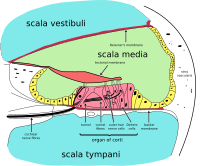
Photo from wikipedia
Infants with congenital deafness caused by severe bilateral inner ear malformations frequently suffer from severe hearing loss and poor balance. Unfortunately, the use of hearing aids is usually ineffective in… Click to show full abstract
Infants with congenital deafness caused by severe bilateral inner ear malformations frequently suffer from severe hearing loss and poor balance. Unfortunately, the use of hearing aids is usually ineffective in recovering hearing, necessitating cochlear implants. We report a case of a 6-year-old boy with congenital deafness and bilateral inner ear malformations (right side, incomplete partition type I [IP-I]; left side, common cavity deformity). Hearing aids had a remarkable effect in this patient, enabling sufficient and favorable hearing recovery such as to allow the patient to engage in daily conversations. Per-rotatory nystagmus was recorded on an electronystagmogram for both right and left rotations in a damped rotational chair test. It is rare for deaf children with severe bilateral inner ear malformation to demonstrate favorable development in hearing and good equilibrium function. Our findings suggest that auditory–vestibular hair cells in this patient may have been partially preserved despite IP-I in the right ear and common cavity deformity of the left ear.
Journal Title: Journal of Otology
Year Published: 2017
Link to full text (if available)
Share on Social Media: Sign Up to like & get
recommendations!